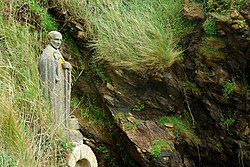Gildas
| Gildas | |
|---|---|

Statue of Saint Gildas near the village of Saint-Gildas-de-Rhuys (France).
|
|
| Abbot | |
| Born | c. 500 |
| Died | 570 Rhuys, Brittany |
| Venerated in | Eastern Orthodox Church; Roman Catholic Church; Anglican Communion |
| Major shrine | Glastonbury Abbey, now destroyed, or Rhuys Church, extant. |
| Feast | 29 January |
| Attributes | monk holding a Celtic bell or writing in a book |
| Patronage | Welsh historians; bell founders |
Gildas (c. 500–570) — also known as Gildas the Wise or Gildas Sapiens — was a 6th-century British monk best known for his scathing religious polemic De Excidio et Conquestu Britanniae, which recounts the history of the Britons before and during the coming of the Saxons. He is one of the best-documented figures of the Christian church in the British Isles during the sub-Roman period, and was renowned for his Biblical knowledge and literary style. In his later life, he emigrated to Brittany where he founded a monastery known as St. Gildas de Rhuys.
Differing versions of the Life of Saint Gildas exist, but both agree that he was born in what is now Scotland on the banks of the River Clyde, and that he was the son of a royal family. These works were written in the eleventh and twelfth centuries and are regarded by scholars as unhistorical. He is now thought to have his origins further south. In his own work, he claims to have been born the same year as the Battle of Mount Badon. He was educated at a monastic center, possibly Cor Tewdws under St. Illtud, where he chose to forsake his royal heritage and embrace monasticism. He became a renowned teacher, converting many to Christianity and founding numerous churches and monasteries throughout Britain and Ireland. He is thought to have made a pilgrimage to Rome before emigrating to Brittany, where he took on the life of a hermit. However, his life of solitude was short-lived, and pupils soon sought him out and begged him to teach them. He eventually founded a monastery for these students at Rhuys, where he wrote De Excidio Britanniae, criticising British rulers and exhorting them to put off their sins and embrace true Christian faith. He is thought to have died at Rhuys, and was buried there.
There are two different historical versions of the life of Gildas, the first written by an anonymous monk in the 9th century, and the other written by Caradoc of Llancarfan in the middle of the 12th century. Some historians have attempted to explain the differences in the versions by saying that there were two saints named Gildas, but the more general opinion is that there was only one St. Gildas and that the discrepancies between the two versions can be accounted for by the fact that they were written several centuries apart. The 9th century Rhuys Life is generally accepted as being more accurate.
...
Wikipedia
